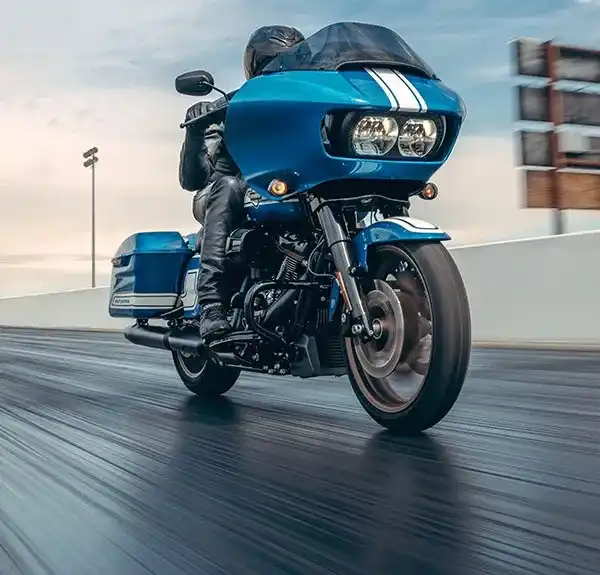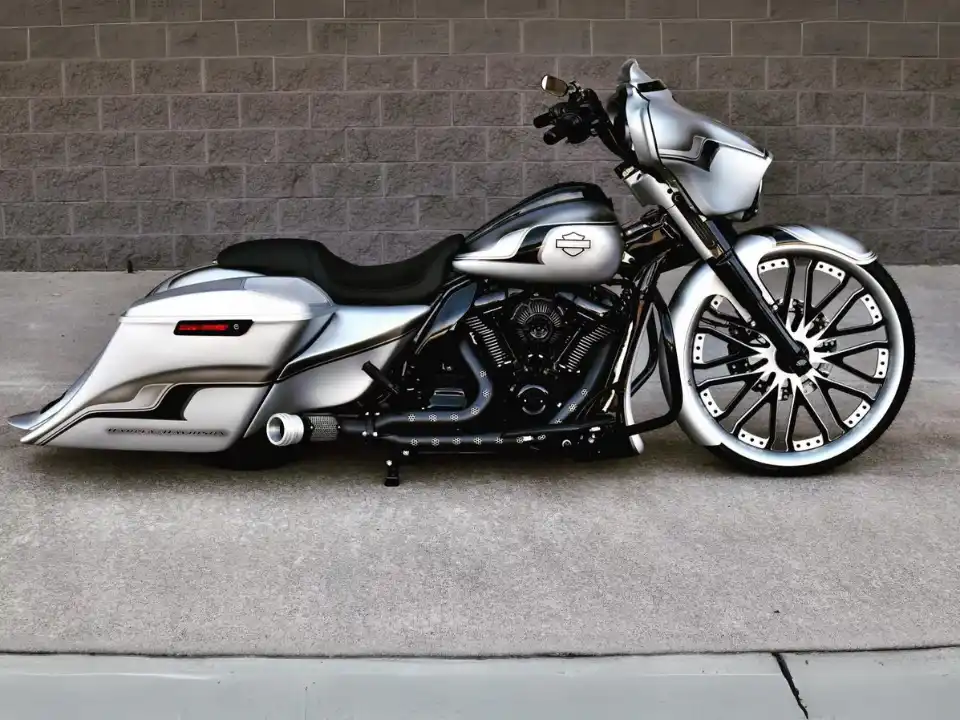Harley-Davidson’s Road Glide and Street Glide models are two of the most celebrated motorcycles in the touring segment, each embodying a unique blend of style, performance, and comfort.
While they share much of the same DNA, subtle yet significant differences set them apart, catering to diverse rider preferences and riding conditions. This article explores these differences in depth, covering design, performance, comfort, technology, customization, and price to help you decide which bike suits your riding style best.
Design and Styling: Batwing vs. Sharknose
The most immediately noticeable difference between the Street Glide and Road Glide lies in their front fairings. The Street Glide sports the classic batwing fairing, a design that has become synonymous with Harley-Davidson’s cruiser heritage. Mounted directly to the forks, this fairing moves with the handlebars, giving the bike a traditional and somewhat nostalgic look. This setup offers an open, connected feeling to the road, appealing to riders who enjoy the classic cruiser aesthetic and the sensation of steering with the wind.
In contrast, the Road Glide features a distinctive sharknose fairing that is mounted to the frame rather than the forks. This fixed fairing does not turn with the handlebars, creating a more aggressive and streamlined front profile. The frame-mounted design improves aerodynamics and reduces rider fatigue by minimizing wind buffeting, especially on long highway rides.
The sharknose fairing also sits slightly farther forward, which can provide extra comfort and room for taller riders. This modern styling and functional design make the Road Glide stand out as a touring-focused machine built for stability and comfort over long distances.
Performance and Handling: Stability vs. Agility
Both the Street Glide and Road Glide are powered by Harley-Davidson’s Milwaukee-Eight 117 V-Twin engine, delivering robust power and smooth torque. This engine ensures that riders get a thrilling yet manageable ride, whether cruising city streets or carving through mountain roads. Despite sharing the same powerplant, the two bikes handle differently due to their fairing designs and chassis setups.
The Street Glide’s fork-mounted batwing fairing contributes to a lighter and more responsive feel, particularly noticeable in city traffic and slower-speed maneuvers. This makes the Street Glide feel agile and nimble, ideal for riders who prioritize maneuverability and a more connected riding experience.

On the other hand, the Road Glide’s frame-mounted sharknose fairing adds stability, especially at higher speeds and on highways. By decoupling the fairing from the steering, the Road Glide reduces front-end weight and wind buffeting, resulting in a steadier ride with less rider fatigue on long journeys. Riders often find the Road Glide better suited for extended touring, where stability and comfort take precedence over quick handling.
Comfort and Ergonomics: Tailored for Touring
Comfort is a critical factor for touring motorcycles, and both the Road Glide and Street Glide offer well-thought-out ergonomics to keep riders comfortable on long rides. The seating positions on both bikes are designed to provide a relaxed posture, but the Road Glide’s fixed fairing offers superior wind protection. This reduces fatigue by shielding the rider from wind pressure, making it easier to maintain focus and comfort over hundreds of miles.
The Road Glide also features a slightly taller seat height, about half an inch higher than the Street Glide, which can benefit taller riders by providing more legroom and a less cramped riding position. Suspension setups on both models are advanced and adjustable, but many riders report that the Road Glide’s design allows it to handle rough roads more effectively. Because the fairing is mounted to the frame rather than the forks, it doesn’t add extra weight to the front suspension, helping the bike absorb bumps and irregularities with greater ease.
Conversely, the Street Glide’s batwing fairing offers a more open feel, allowing riders to enjoy the breeze and a sense of freedom. While it may not provide quite the same level of wind protection as the Road Glide, it still offers ample comfort for most riding conditions, making it a versatile choice for both city cruising and moderate touring.
Technology and Features: Modern Infotainment and Connectivity
Both the Road Glide and Street Glide come equipped with Harley-Davidson’s latest Boom! Box GTS infotainment system. This advanced system features a large touchscreen display, GPS navigation, Bluetooth connectivity, and premium audio options. Riders can easily connect their smartphones, stream music, and access turn-by-turn directions, making long rides more enjoyable and less stressful.

Storage capacity is generous on both models, with spacious saddlebags designed to hold gear for extended trips. The Road Glide often has a slight edge in total storage volume, thanks to its touring-focused design. Both bikes also offer a range of rider aids and safety features, including ABS brakes, cruise control, and advanced suspension options, ensuring a safe and comfortable ride regardless of conditions.
Customization and Personalization: Making It Your Own
One of the hallmarks of Harley-Davidson motorcycles is the extensive range of customization options available to riders. Both the Road Glide and Street Glide benefit from a vast aftermarket and factory accessory market, allowing owners to tailor their bikes to their personal style and riding needs.
The Road Glide, with its touring-centric design, often attracts riders who prioritize comfort and convenience, leading to popular upgrades like heated seats, larger saddlebags, and enhanced audio systems. The Street Glide’s classic cruiser appeal makes it a favorite among riders who enjoy aesthetic customizations, including paint schemes, chrome accents, and performance upgrades. Both bikes offer endless possibilities to make the ride truly your own.
Price and Value: Choosing Based on Priorities
Pricing for the Road Glide and Street Glide is generally competitive, with the Road Glide typically carrying a slight premium due to its additional touring features and frame-mounted fairing design. However, the final cost can vary widely depending on model year, trim level, and optional accessories. Ultimately, the choice between the two often comes down to personal preference and intended use rather than price alone.
For riders focused on long-distance touring and highway stability, the Road Glide offers excellent value through its enhanced comfort and aerodynamic advantages. Those who prefer a more traditional cruiser experience with agile handling and classic styling may find the Street Glide better suits their needs.
Conclusion: Which Harley-Davidson Touring Bike Is Right for You?
The Harley-Davidson Road Glide and Street Glide both represent the pinnacle of American touring motorcycles, each offering a compelling blend of power, comfort, and style. The Road Glide’s frame-mounted sharknose fairing and touring-focused features make it an ideal choice for riders who prioritize stability, wind protection, and long-distance comfort. Meanwhile, the Street Glide’s iconic batwing fairing and nimble handling appeal to those who value classic styling and a more connected riding experience.
Choosing between these two iconic models ultimately depends on your riding style, comfort preferences, and the types of journeys you envision. Whether you lean toward the aggressive, aerodynamic Road Glide or the traditional, agile Street Glide, both motorcycles promise an unforgettable ride and a deep connection to Harley-Davidson’s legendary heritage.